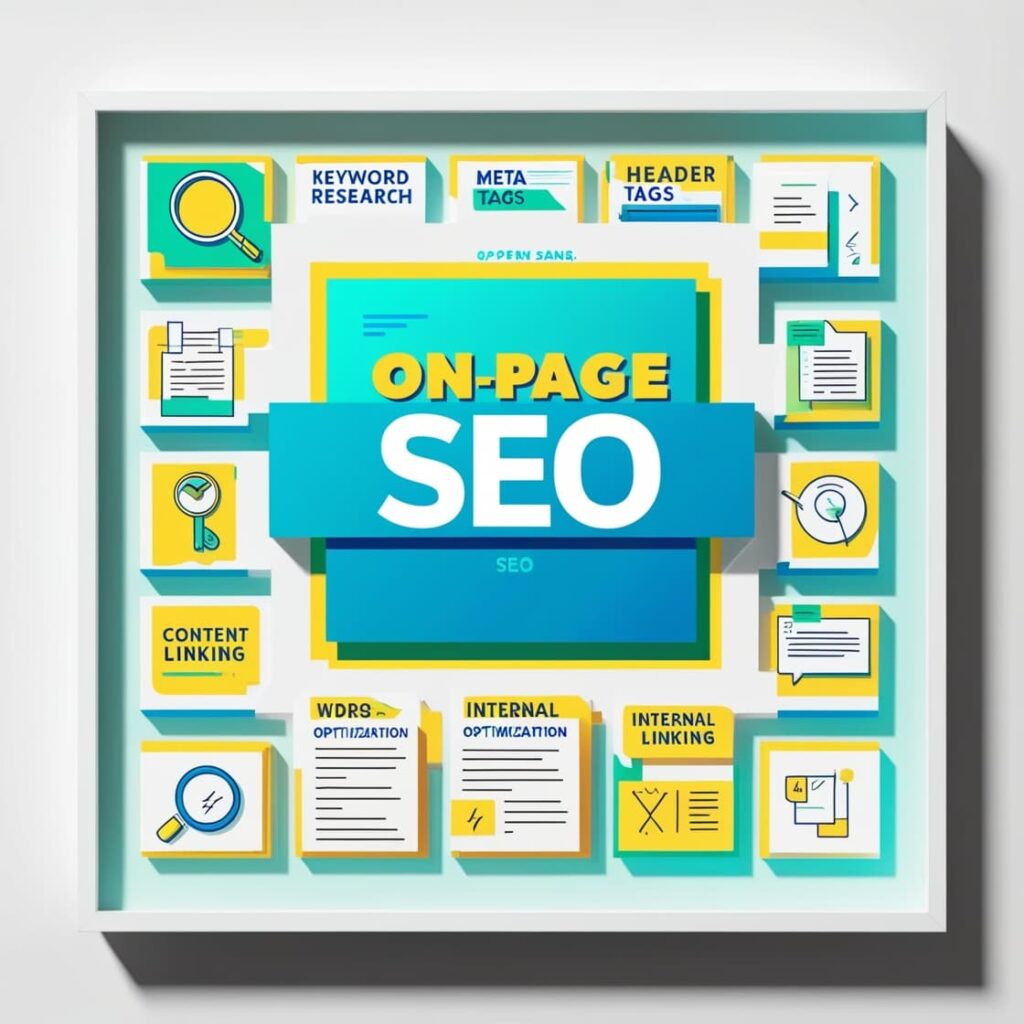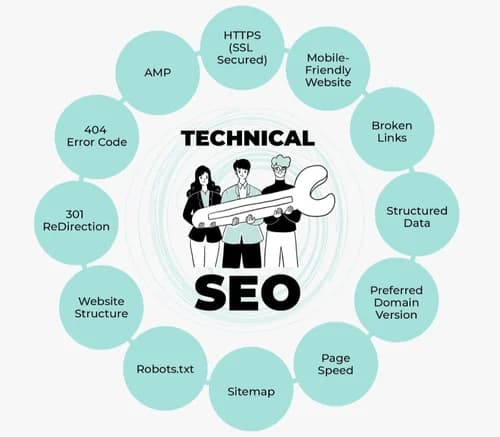On-page SEO means optimizing your site’s content and structure. It means changing your website to boost its visibility in search engine results pages (SERPs).
Here are some key components of on-page SEO:
- Keyword Research and Optimization: Identifying and strategically using relevant keywords throughout your website.
- Page Titles and Meta Descriptions: Write catchy titles and descriptions. They should summarize your page’s content and include relevant keywords.
- Headings and Subheadings: Use headings (H1, H2, H3, etc.) to structure your content and include keywords.
- Content Quality and Relevance: Make high-quality, engaging content. It must inform and meet your audience’s needs.
- Image Optimization: Optimize images for size, format, and alt text. This improves load times and search engine visibility.
- Internal Linking: Linking to relevant pages on your site to improve navigation and share link authority.
- URL Structure: Creating clean and descriptive URLs that include relevant keywords.
- Mobile-Friendliness: Optimize your website for mobile devices.
- Page Speed: Improve your site’s load speed. This boosts user experience and search rankings.
- User Experience (UX): A website that is easy to use, looks good, and is easy to navigate.
On-page SEO can boost your site’s search visibility and attract more traffic.
Keyword Research and Optimization
Keyword relevance is a fundamental aspect of on-page SEO. It means finding and using relevant keywords in your website’s content. This will improve your search engine rankings and attract organic traffic. Here’s a deeper dive into this crucial component:
Understanding Keyword Relevance
Target Audience: Find the keywords your audience will search for when looking for your products or services.
Search Intent: Consider the intent behind the search query. Are users looking for information, products, or services?
Keyword Difficulty: Evaluate the competition for your chosen keywords. Highly competitive keywords are hard to rank for. Targeting long-tail keywords (more specific phrases) can be more effective.
Keyword Placement
Incorporate your target keyword in a natural way in the page title.
Meta Descriptions: Use your keyword in the meta description. It should summarize the page’s content. Meta Description should between 150 – 160 characters. Its ideal for almost all Search Engine Crawlers.
Use headings (H1, H2, H3, etc.) to structure your content. Include relevant keywords. Use keyword in headings also.
Integrate keywords naturally into your body text. But, avoid keyword stuffing (excessive repetition). For example you have an article of 600 words, use keyword 6 to 8 times in 600 words lengthy article.
Keyword Density
Optimal Density: There’s no exact formula for keyword density. Aim for a natural balance. Don’t overstuff your content with keywords. It can hurt user experience and your search engine rankings.
Keyword Variation: Use synonyms and related terms to avoid keyword repetition.
Keyword Research Tools
Google Keyword Planner is a free Google tool. It helps you find relevant keywords and estimate their search volume.
SEMrush is a paid SEO tool. It offers keyword research, competitor analysis, and backlink tracking.
Ahrefs is another popular paid SEO tool with similar features to SEMrush.
if you want to read more about Best AI Tools for SEO you can read this article.
Use keyword research and optimization to boost your site’s visibility in search engine results pages (SERPs). This will attract more organic traffic. Remember, the goal is to create high-quality, useful content for your target audience. Also, incorporate relevant keywords naturally and strategically.
Page Titles and Meta Descriptions
Page titles and meta descriptions are key SEO elements. They are vital for attracting clicks from search engine results pages (SERPs). They summarize your page’s content. They can greatly affect your search engine rankings.
Compelling Titles
Keyword Inclusion: Incorporate your target keyword naturally into the page title. It helps search engines understand your page’s topic. This improves your chances of ranking for relevant searches.
Informative and Engaging: Make your titles catchy and informative. This will entice users to click your link. A strong title should match your page’s content and spark curiosity.
Length: Keep your titles concise, typically around 50-60 characters. Search engines may truncate titles that exceed this length.
Descriptive Meta Descriptions
Summary of Content: The meta description gives a short summary of your page’s content. It should accurately describe what users can expect to find on the page.
Call to Action: Add a call to action in your meta description. It can encourage users to click through.
Keyword Placement: Include your target keyword in the meta description. But, avoid keyword stuffing. Aim for a natural placement that flows well with the rest of the text.
Length: Meta descriptions are typically limited to around 150-160 characters.
Craft strong titles and meta descriptions. They will boost your site’s CTR and organic traffic. Users are more likely to click on results with engaging, relevant titles and meta descriptions.
Headings and Subheadings
Headings and subheadings are key to on-page SEO. They organize your content and make it more readable. A clear hierarchy of headings makes your content more appealing. It helps search engines understand it better, too.
Hierarchical Structure
H1 Tag: The main heading for your page, typically used once per page.
H2 Tag: Secondary headings that break down your content into sections.
H3 Tag: Tertiary headings that provide further subheadings within sections.
H4, H5, and H6: Additional levels of headings for more specific sections.
By using headings in a logical hierarchy, you create a clear structure for your content. It helps readers navigate your page. It also helps search engines understand your content’s topic and structure.
Keyword Inclusion
Relevance: Incorporate relevant keywords into your headings. It helps search engines understand each section’s topic. This improves your chances of ranking for relevant search terms.
Keyword Placement: Include keywords in your headings. But, avoid keyword stuffing. Aim for a natural and informative placement.
Heading Hierarchy: Use varied-level headings to show each section’s importance. For example, your main heading (H1) is the most important. Then, use secondary (H2) and subordinate(H3) headings.
Effective use of headings and subheadings can improve your website. It will be more readable and user-friendly. It will also rank better in search engines. A well-structured page is easier to navigate. It helps search engines to understand it. This leads to higher visibility and more traffic.
Content Quality and Relevance
Content is the King. High-quality, relevant content is vital for users and SEO. Create valuable content that meets your audience’s needs. It will boost your website’s rankings, attract traffic, and build trust.
Value-Added Content
Informative and Engaging: Your content should be informative, engaging, and easy to understand. Avoid technical jargon and use clear and concise language.
Problem-Solving: Address your target audience’s pain points and offer solutions. This demonstrates your expertise and helps establish your website as a valuable resource.
Unique Perspective: Provide a unique perspective or angle on your topic. This can help your content stand out from the competition and attract more attention.
Call to Action: Add a clear call to action. It should encourage visitors to take the desired action, like buying, subscribing, or contacting you for more info.
Relevance
Keyword Alignment: Ensure that your content is relevant to your target keywords. Use keywords naturally throughout your content, but avoid keyword stuffing.
Topic Alignment: Your content should be closely related to the topic of your page. Avoid unrelated content that can confuse visitors and harm your search engine rankings.
User Intent: Consider the search intent behind your target keywords. Are users looking for information, products, or services? Tailor your content to match their intent.
Create high-quality, relevant content that meets your audience’s needs. This can improve your website’s rankings, attract traffic, and establish your site as an industry authority. Quality content is a long-term investment. It can provide value for years.
Image Optimization
Images are vital to many websites. But, if not optimized, they can slow load times and hurt search rankings. Here’s how to optimize your images for both accessibility and SEO:
Alt Text
Descriptive Text: Use alt text that accurately describes the image. This helps visually impaired users understand the image and improves accessibility.
Keyword Inclusion: Include relevant keywords in your alt text. This helps search engines understand the image and improves your rankings.
Avoid Keyword Stuffing: Include relevant keywords, but don’t stuff them in your alt text.
Length: Keep your alt text concise and to the point.
File Size and Compression
Compression: Use image compression tools. They will reduce your images’ file size without losing quality. This can significantly improve page load times. A very famous image compressor is TinyPng.
Image Format: Choose the appropriate image format based on the image’s content. JPEG works best for photos. PNG is better for images with transparency or text. Webp format is also very quick to load but webp image format is not support in all browsers.
Image Dimensions: Resize images to the appropriate dimensions for your website. Using larger images than necessary can increase load time.
Optimizing your images for accessibility and SEO can improve your website’s user experience and boost its search engine rankings.
Internal Linking
Internal linking means linking to other pages on your website. This technique can improve your site’s navigation and search rankings. It will also distribute link authority. For example, your website is bitcodesolution. If you mention it in an article, you must link to it.
Interconnected Structure
Improved Navigation: Linking to relevant pages within your site creates a more interconnected structure. This helps users navigate your site easily.
Link Authority: Internal links can help distribute link authority throughout your website. When you link to a page, you’re essentially passing some of your page’s authority to the linked page. This can help improve the rankings of important pages on your site.
Anchor Text
Descriptive Anchor Text: Use descriptive anchor text. It should clearly indicate the linked page’s content. For example, instead of linking to a page with the text “Click here,” use a more specific anchor. For instance, use “Learn more about our products.””
Keyword-Rich Anchor Text: Add relevant keywords to your anchor text. This helps search engines understand the linked page’s content. However, avoid keyword stuffing.
Good use of internal links can improve your site’s navigation. It can also distribute link authority and boost your search rankings. Link to relevant pages. Use descriptive anchor text. This improves user experience and boosts your SEO.
URL Structure
Your website’s URL structure can greatly affect your search rankings. You can improve your site’s visibility and user experience. Create clean, descriptive URLs that include relevant keywords.
Keyword-Rich URLs
Clarity and Relevance: Use easy-to-read URLs with relevant keywords. It helps search engines understand your page’s content. This improves your chances of ranking for relevant search terms.
Keyword Placement: Put your target keyword near the start of the URL. Avoid keyword stuffing.
Human-Readable URLs: Create URLs that are easy for users to remember and share. Avoid using long, complex URLs that are difficult to understand.
Avoid Dynamic URLs
Static URLs: Static URLs are more readable and easier for search engines to index. They typically use a simple structure, such as bitcodesolution.com/page-name.
Dynamic URLs: They often have parameters or query strings. This can make them hard to read and understand. Dynamic URLs may be needed for some website functions. But, use static URLs whenever possible.
Use clean, descriptive URLs with relevant keywords. Avoid dynamic URLs. This will boost your site’s SEO and user experience. A good URL can help your site stand out in search results. It can attract more organic traffic.
Mobile-Friendliness
Mobile-friendliness is a critical aspect of on-page SEO. As more people use mobile devices to browse the web, your site must be optimized for small screens. Here’s a breakdown of the two main components of mobile-friendliness:
Responsive Design
Adaptive Layout: Responsive design makes your website fit all screen sizes and orientations.
CSS Media Queries: This technique uses CSS rules to set your website’s look and behavior on different devices.
Fluid Grids: A responsive design framework. It uses relative units (like percentages) to create flexible layouts.
Mobile-Specific Content
Tailored Content: Consider making content for mobile users. Use shorter paragraphs, larger fonts, and simpler navigation.
Touch Optimization: Make your website’s elements large enough for easy finger taps.
Mobile-First Approach: Design your site for mobile devices, then adapt it for larger screens.
Prioritizing mobile-friendliness improves the experience for mobile users. It boosts your search engine rankings and increases conversions.
Page Speed
Page speed refers to how quickly your website loads for users. It’s a crucial factor for both user experience and search engine rankings. Slow websites frustrate users and raise bounce rates. Fast ones boost satisfaction and conversions.
Here are some strategies for optimizing your website’s load times:
Optimize Images
Compression: Use image tools to compress your images. Reduce file size without losing quality.
Proper Format: Choose the appropriate image format based on the image’s content. JPEG is best for photos. PNG is better for images with transparency or text.
Lazy Loading: Use lazy loading to load images only when they are visible on the screen. This can help reduce initial page load times.
Reduce Code
Minify CSS and JavaScript: Remove unnecessary characters to reduce file size.
Combine Files: Reduce HTTP requests by merging multiple CSS and JS files into fewer files.
Leverage Caching: Enable browser caching. It will store static resources locally. This reduces the need to download them from the server each time a user visits your website.
Use a Fast Web Host
Server Location: Choose a web host with servers in your target region. This will reduce latency.
Server Resources: Your web host must provide enough server resources (CPU, RAM, storage) for your website’s traffic.
Content Delivery Network (CDN): A CDN can improve load times for users in different locations. It does this by distributing your website’s content across multiple servers worldwide.
Optimizing your website’s load times will improve user experience. It will boost your search engine rankings and increase conversions, too. Remember, even a small improvement in page speed can make a big difference.
We are glad to announce that we are providing hosting services also. To host your site you can contact us on +92 3367366752
User Experience (UX)
A good user experience (UX) is vital for website visitors and SEO. A user-friendly, attractive website will improve user satisfaction. It will reduce bounce rates and boost your search engine rankings.
Easy Navigation
Clear Structure: Organize your website’s content into a simple, logical structure. It should be easy for users to understand. Use a clear and consistent navigation menu to help users find what they are looking for.
Breadcrumbs: Implement breadcrumbs to show users their current location within your website. This helps users grasp your pages’ hierarchy and navigate back.
Internal Linking: Use internal links to connect related pages within your website. It helps users navigate your site and boosts your search rankings.
User-Friendly Design
Visual Appeal: Use a clean and visually appealing design that is easy on the eyes. Avoid clutter and excessive use of bright colors or flashing animations.
Readability: Choose fonts and font sizes that are easy to read. Use sufficient contrast between text and background colors.
Consistency: Maintain a consistent design throughout your website. This helps users understand the structure and navigation of your site.
Mobile-Friendliness: Optimize your website for mobile devices. This will give mobile users a seamless experience.
By prioritizing user experience, you can create a website that is both enjoyable to use and effective for SEO. A good user experience can boost engagement, time on site, and conversions.
These on-page SEO components will boost your site’s search visibility. They will attract more organic traffic. Remember, on-page SEO is just one part of a comprehensive SEO strategy. For the best results, combine on-page SEO with off-page techniques. These include link building and social media marketing.
Do you want to read about Key Components of Off-Page SEO. A detailed Components of Off-Page SEO are written.




